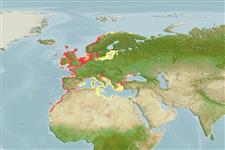Common names from other countries
Environment: milieu / climate zone / depth range / distribution range
Ecologia
; estuarina; intervalo de profundidade 0 - 5 m (Ref. 125442). Subtropical, preferred 10°C (Ref. 107945); 71°N - 14°N, 17°W - 33°E (Ref. 107077)
Eastern Atlantic, the Mediterranean and Black Sea: from Portugal to Egypt, north to Norway and Russia then south to Senegal, including Mediterranean and Black Sea. Occurrence in Iran, Persian Gulf is questionable.
Length at first maturity / Tamanho / Peso / Idade
Maturity: Lm ? range ? - ? cm Max length : 5.6 cm SHL macho/indeterminado; (Ref. 101424); common length : 3.5 cm SHL macho/indeterminado; (Ref. 437); Idade máx. registada: 7 anos (Ref. 2823)
Life cycle and mating behavior
Maturidade | Reprodução | Desova | Ovos | Fecundidade | Larvas
Members of the class Bivalvia are mostly gonochoric, some are protandric hermaphrodites. Life cycle: Embryos develop into free-swimming trocophore larvae, succeeded by the bivalve veliger, resembling a miniature clam.
Fischer, W., G. Bianchi and W.B. Scott (eds.). 1981. (Ref. 437)
Categoria na Lista Vermelha da IUCN (Ref. 130435: Version 2024-1)
Categoria CITES (Ref. 108899)
Not Evaluated
Not Evaluated
Utilização humana
Pescarias: espécies comerciais
FAO - Aquacultura: produção; pescarias: landings, perfil da espécie | FishSource | Sea Around Us
Ferramentas
Fontes da internet
Estimates based on models
Preferred temperature
(Ref.
115969): 7.6 - 13.7, mean 10.4 (based on 742 cells).
Resiliência
Elevada, tempo mínimo de duplicação da população menor que 15 meses (K=0.46-0.66; tmax=7).
Prior r = 0.49, 95% CL = 0.33 - 0.74, Based on 1 data-limited stock assessment.
Vulnerabilidade
Low to moderate vulnerability (28 of 100).
